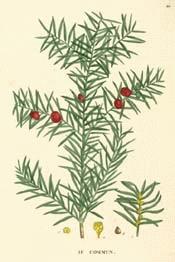
Botanical.com Home Page

|
Yew
(Taxus brevifolia printed as
Taxus baccata)
Click on graphic for larger image
|
Yew
POISON!
Botanical: Taxus baccata
Family: N.O. Taxaceae and Coniferae
---Poisonous Parts---Leaves, seed and fruit.
---Habitat---Europe, North Africa, Western Asia.
---Description---A tree 40 to 50 feet high, forming with age a very stout trunk covered with red-brown, peeling bark and topped with a rounded or wide-spreading head of branches; leaves spirally attached to twigs, but by twisting of the stalks brought more or less into two opposed ranks, dark, glossy, almost black-green above, grey, pale-green or yellowish beneath, 1/2 to 1 1/2 inches long, 1/16 to 1/12 inch wide. Flowers unisexual, with the sexes invariably on different trees, produced in spring from the leaf axils of the preceding summer's twigs. Male, a globose cluster of stamens; female, an ovule surrounded by small bracts, the so-called fruit bright red, sometimes yellow, juicy and encloses the seed.
No tree is more associated with the history and legends of Great Britain than the Yew. Before Christianity was introduced it was a sacred tree favoured by the Druids, who built their temples near these trees - a custom followed by the early Christians. The association of the tree with places of worship still prevails.
Many cases of poisoning amongst cattle have resulted from eating parts of the Yew.
---Constituents---The fruit and seeds seem to be the most poisonous parts of the tree. An alkaloid taxine has been obtained from the seeds; this is a poisonous, white, crystalline powder, only slightly soluble in water; another principle, Milossin, has also been found.
---Uses---The wood was formerly much valued in archery for the making of long bows. The wood is said to resist the action of water and is very hard, and, before the use of iron became general, was greatly valued. (In homoeopathy a tincture of the young shoots and also of the berries is used in a variety of diseases: cystitis, eruptions, headache and neuralgia, affections of the heart and kidneys, dimness of vision, and gout and rheurmatism. - EDITOR)
[Top]
Common Name Index
A MODERN HERBAL Home Page
Bear in mind "A Modern Herbal" was written with the conventional wisdom of the early 1900's. This should be taken into account as some of the information may now be considered inaccurate, or not in accordance with modern medicine.
© Copyright Protected 1995-2025 Botanical.com
|

